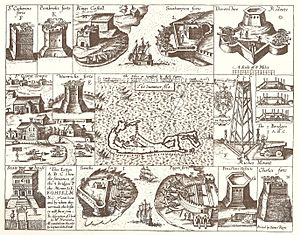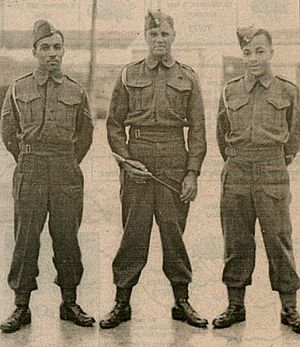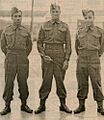Militia (British Dominions and Crown Colonies) facts for kids
The Militia of the British Dominions, Self-Governing Colonies, and Crown Colonies were like local armies in different parts of the British Empire. These groups were made up of ordinary citizens who could be called upon to defend their homes and lands. They were the main military forces in places called Dominions (like Canada), Self-governing colonies (which had their own elected governments), and Crown Colonies (which were ruled directly by the British government).
Contents
A Look Back: Early Militias
The English started forming these local defense groups, called militias, very early on. They began in their colonies in the New World in the early 1600s. While militias in England weren't used much, except during the English Civil Wars, they were very important in the North American colonies.
Militias in the Americas
In many battles against Native Americans and other European rivals, these militias were the main English fighting force. This was because professional soldiers were often far away. Even when the English colonies grew into the British Empire, and regular soldiers became more available, militias were still a key part of Britain's military strength in the Americas. The British victory over Spain and France in the Seven Years' War wouldn't have happened without the colonial militias and their Native allies. In fact, it was having their own militias that allowed the thirteen American colonies to start the American War of Independence.
Militias Around the World
Australasia: No Official Militias
Interestingly, the colonies in Australia didn't have militias. New Zealand also didn't officially have them. In 1843, a local militia formed in Wellington, New Zealand, without official permission. It was quickly disbanded.
Bermuda: A Unique Story

Bermuda, also known as the Somers Isles, was settled in 1609. It was a self-governed colony, meaning it had its own local government. Bermuda's militia story was a bit different. It eventually became less active after the War of 1812. By then, many regular British soldiers were stationed there, so the militia wasn't needed as much.
However, for its first hundred years, Bermuda's militia was the colony's only defense. They guarded its forts and coastal guns, and called up all available men during wartime.
Challenges and Rights
After the Cromwellian conquest of Ireland, many Irish prisoners of war and civilians were sent to Bermuda. They often disagreed with the English population. In 1661, the Bermudan government worried about a plot by enslaved Black people and Irish people to harm the English residents. The Irish were seen as the main planners. To prevent this, Governor William Sayle made three rules:
- A nightly watch would be set up.
- All enslaved people and indentured servants had to give up their weapons.
- Any group of two or more enslaved people or indentured servants would be broken up by whipping.
- No more Irish prisoners or civilians were allowed to be sent to Bermuda.
Even with these rules, enslaved Bermudians continued to serve in the colonial militia. This led to an important decision about their rights. By the 1700s, most Bermudian men worked in shipping, building and sailing ships. The colony relied so much on its sailors that the Royal Navy didn't force them into service, unlike other sailors in the British Empire. Bermuda's merchant ships, which often became privateers during wars, were required by local law to have a certain number of Black sailors, many of whom were enslaved.
British law said that all crew members on British ships had to be British subjects. But the status of enslaved Bermudians was unclear. When a Bermudian ship was stopped by a Royal Navy warship because of its enslaved crew, the ship owners argued in court. They said that because Bermuda's enslaved people served in the militia, they should be considered British subjects. The courts agreed with this view.
Bermuda's Fortifications
The Bermudian settlers who seasonally visited the Turks Islands also formed militias there. Their valuable salt trade often attracted attacks from enemies like France and Spain, and even from the Bahamas.
The forts built in Bermuda by the militia, including the Castle Islands Fortifications, started in 1612. These are the oldest English colonial structures in the Americas. They were also the first stone forts, had the first coastal artillery, and are the oldest surviving forts built by the English in the New World. The militia manned these forts with artillery soldiers until the regular British Army took over after the American War of Independence. Some forts, like Fort St. Catherine's, were used well into the 1900s.
Modern Bermudian Forces
As more regular British soldiers were stationed in the Bermuda Garrison, the local government in Bermuda decided the Militia Act was no longer needed after the War of 1812. The militia was seen as unnecessary. The British government couldn't force Bermuda to raise reserve forces again until the 1890s. That's when the Bermuda Militia Artillery (BMA) and the Bermuda Volunteer Rifle Corps (BVRC) were created. The BVRC was a volunteer group, not a militia.
Later, in the 1930s, the Bermuda Militia Infantry (BMI) and the Bermuda Volunteer Engineers (BVE) were added. The BMA and BVRC served during World War I and sent soldiers to the front lines. In the 1920s, they were reorganized as Territorial units, but kept their original names. The BMI and BVE were also raised as territorials, but their names were a bit misleading. All four units served throughout World War II, sending soldiers overseas.
In 1949, the Defence Act reorganized Bermuda's territorial forces. Only the BMA and BVRC remained. The BVRC was renamed the Bermuda Rifles. In 1965, the Bermuda Militia Artillery (which became infantry in 1953 but kept its name) and the Bermuda Rifles joined together to form the Bermuda Regiment. Since 2015, it's been known as the Royal Bermuda Regiment.
British West Indies Militias
Many islands in the British West Indies also had their own militias. These included:
- Anguilla Militia
- Antigua Militia
- Bahamas Militia
- Barbados Militia
- British Guiana Militia
- Grenada Militia
- Jamaica Militia
- Jamaica Militia Artillery
- Montserrat Militia
- Nevis Militia
- Prince Regent's Royal Honduras Militia
- St. Christopher Militia (St. Kitts Militia)
- St. Vincent Militia
- Tobago Militia
- Trinidad Militia
- Virgin Islands Militia
Canada: A Long History
Militia units in Canada have a long history, dating back to New France when French units were formed after 1669. The Companies of Canadian Volunteers were created for the Invasion of Quebec in 1775. These companies became a unit of three companies leading French Canadian troops in 1777 and stayed active until 1783.
The British colonial militia units in Canada were most important during the War of 1812. They continued to be used into the late 1800s, with the last enrollment in 1873, and officially ended in 1950.
Images for kids




